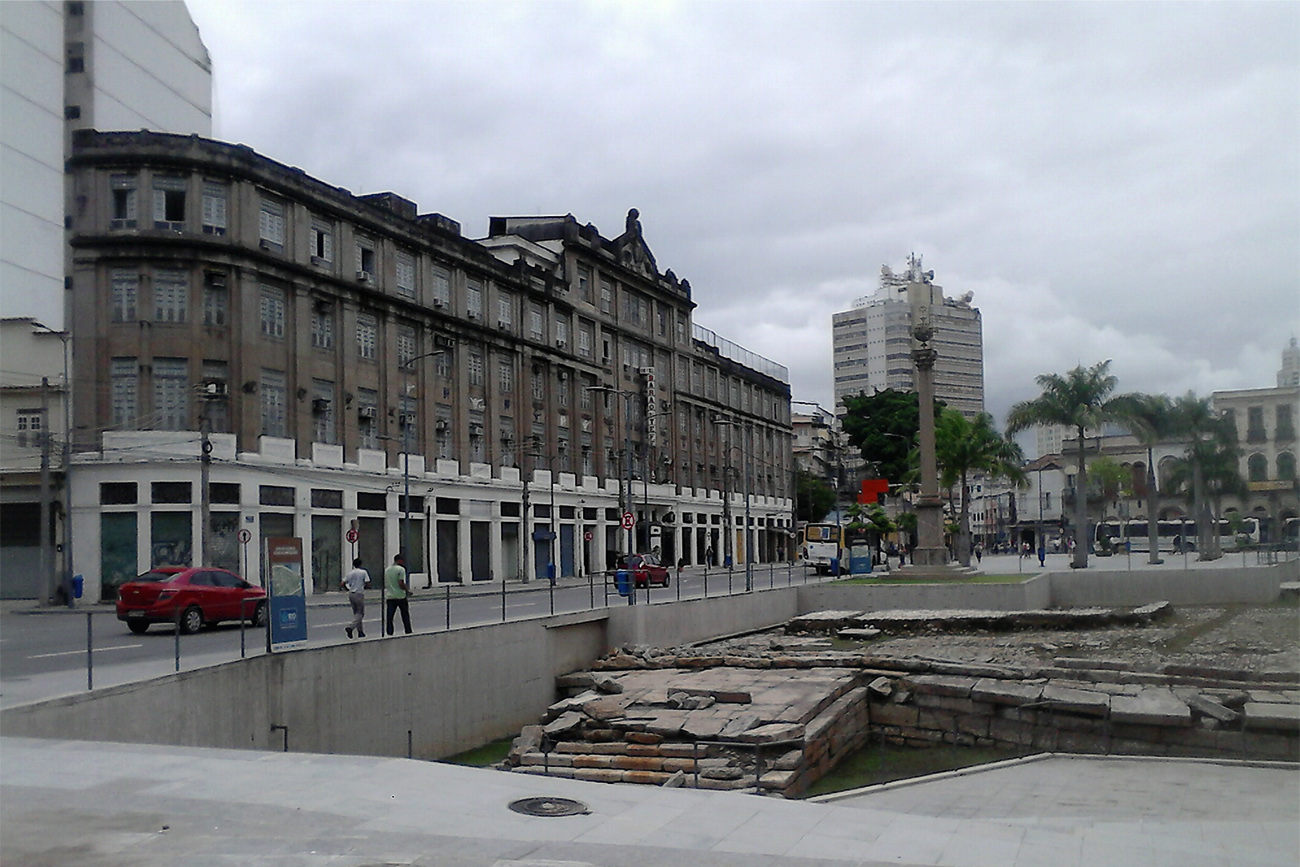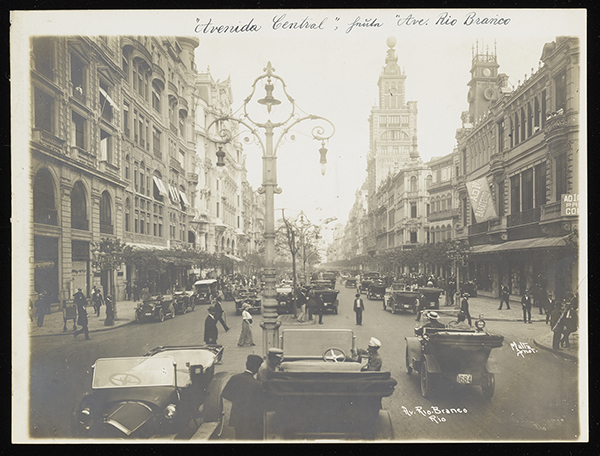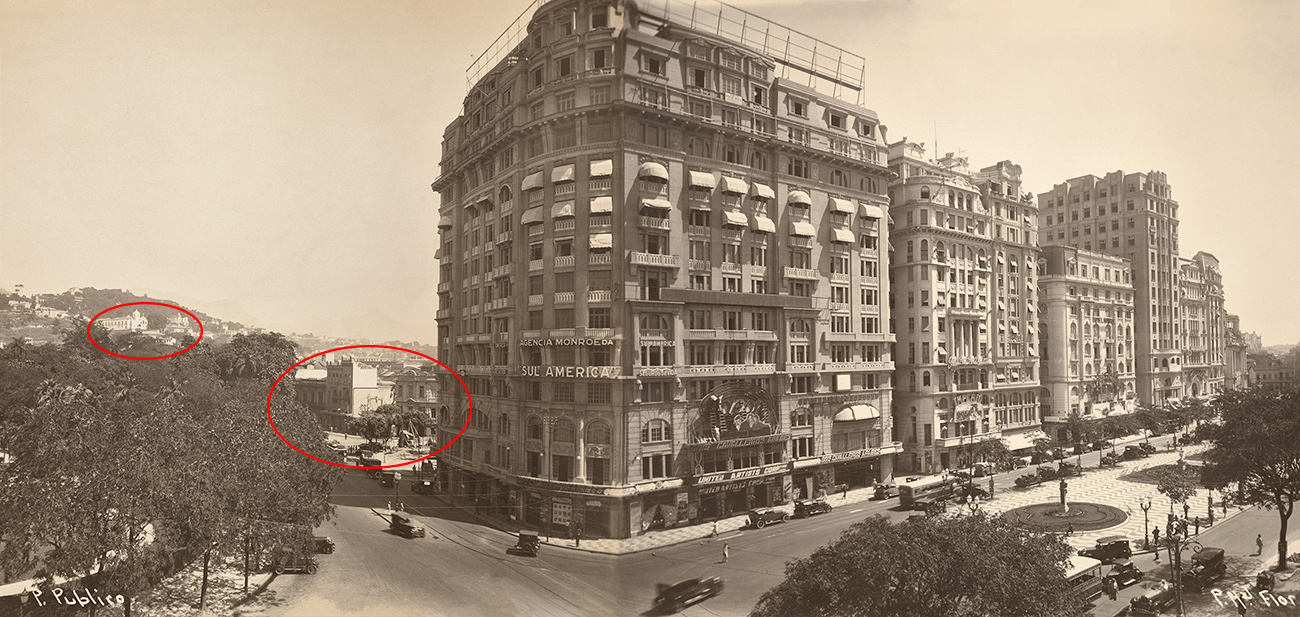
Valongo Wharf, Rio de Janeiro, Brazil, December 13, 2013 (photo: Wagner Tamanaha, CC BY-SA 2.0)
In 2011 an archeological site of global importance resurfaced in Rio de Janeiro: the Cais do Valongo (Valongo Wharf)—once the main port of entry for enslaved Africans in the Americas. Over the course of more than three centuries, the Portuguese colony of Brazil bought and exploited the largest number of African slaves in the Americas, with some estimates reaching over four million. In addition to layers of cobblestoned floor dating back two centuries, archeologists uncovered thousands of objects that belonged to the African slaves, such as amulets, rings, ceramics, smoking pipes, horns and shells, and copper coins. Six years after the excavation, in July 2017, UNESCO recognized the Cais do Valongo as a World Heritage Site, acknowledging its importance as a physical trace of a horrendous human history that should never be forgotten or repeated.
The archeologist Tania Andrade Lima, who worked on the Cais do Valongo excavation, once remarked that historical archeology is an antidote to social amnesia.[1] The anthropologist and historian Lilia Schwarcz suggested a similar idea when she stressed the importance of the Cais do Valongo as a “memory space” for contemporary Brazil, a country whose social dynamics and racial inequalities are profoundly marked by its violent colonial past.[2] Coined by French philosopher Pierre Nora, “memory space” refers to material sites and objects, as well as immaterial vestiges, that have a symbolic meaning for collective memory. According to Schwarcz, memory spaces are far from being natural, stable entities. On the contrary, a collective effort is required to create these spaces, invest them with symbolic meanings, and keep the memories they hold alive.

Avenida Rio Branco, Rio de Janeiro, 1925, Augusto Cesar de Malta Campos (Brazilian, 1864–1957). Gelatin silver print, 7 x 9 ½ in. The Getty Research Institute, 92.R.14
Archives and museums can be part of that effort, as they reveal forgotten histories through their collections and exhibitions. Such is the case for The Metropolis in Latin America: 1830–1930, on view at the Getty Research Institute until January 7, 2018, which looks at the transformation of six capitals in Latin America, including Rio de Janeiro, from colonial cities to modern metropolises. By highlighting important sociopolitical events—including a redevelopment campaign that erased the Cais do Valongo from public view—that shaped the urban plans of these cities, it tells the history of how memory spaces have been both hidden and revealed by cycles of construction and demolition.
While the story of the Cais do Valongo—from its use in the slave trade to its multiple renovations and relevance in the present day—is not told directly in The Metropolis in Latin America: 1830–1930, it is an essential part of Rio de Janeiro’s history. In recognition of its recent World Heritage Site designation, it is fitting to contribute to the construction of the Cais do Valongo as a memory space by telling that story here.
Covering up History
Even after gaining independence from Portugal in 1822, Brazil continued the practice of slavery and was the last country in the Americas to abolish it—in 1888, a year before becoming a republic. Beginning in 1811, the year of its construction, and through the next two decades of its operation, approximately a million Africans walked on the Cais do Valongo’s paved floors before being subjugated to the gruesome process of having their bodies exchanged for money.
The Cais do Valongo was initially paved using a technique common in colonial towns: pé de moleque, which literally translates to “boy’s foot.” Stones of irregular shape and size were arranged in a layer of sand that street children flattened by tramping on them. The pé de moleque was covered in granite blocks in 1843 for the arrival of Empress Teresa Cristina, from Sicily, who was betrothed to the Emperor of Brazil Dom Pedro II. The Cais do Valongo was renamed the Cais da Imperatriz (Empress Wharf) to conceal its past as a site of misery and mistreatment.
The wharf was completely covered again in 1911 as part of the urban renovation championed by the mayor of Rio de Janeiro, Francisco Pereira Passos, in his attempt to modernize the city as the capital of the young federal republic.
A century later, the Cais do Valongo was unearthed during the excavation phase of another urban renewal campaign that was part of an ambitious plan to renovate the historic port area of the city in anticipation of the 2016 Olympic Games.
The City at Large
The Metropolis in Latin America explores the urban renewal of Rio de Janeiro, promoted by the aforementioned Pereira Passos, the mayor of the city from 1902 to 1906, when Rio de Janeiro was still Brazil’s capital. Like his contemporaries, Pereira Passos was inspired by Baron Georges-Eugène Haussmann, the prefect of Paris between 1853 and 1870, who implemented an extensive urban renewal project in the French city half a century before. Pereira Passos’s changes not only affected the site of the Cais do Volango but also the former slaves and residents who lived nearby it.
Two Brazilian photographers documented the metamorphosis of the cityscape in Pereira Passos’s era. Marc Ferrez (1843–1923) and Augusto Malta (1864–1957) captured the recently opened carioca avenues, lined with eclectic Art Deco architecture, richly decorated iron lampposts, and sidewalks paved in mosaics of Portuguese stone. A careful eye, though, can notice that behind the elegant buildings, the photographs sometimes also captured low-rise, modest dwellings—the colonial adjacent to the modern.

Older, smaller buildings (visible in the circled areas) co-exist with newer multi-story buildings in Street View of the Floriano Promenade in Rio de Janeiro, 1928, Augusto Cesar de Malta Campos (Brazilian, 1864–1957). Gelatin silver print, 7 x 9 ¼ in. The Getty Research Institute, 92.R.14
Major public works, including a sanitation system, and the beautification of the city came at the cost of large-scale demolitions of residential quarters and the displacement of their populations. While the affluent moved to salubrious neighborhoods at a distance from the city center and along the beaches, such as Botafogo and Copacabana, the lower classes were displaced to the outskirts of the city, forming the first favelas (shantytowns).
Freed slaves and their descendants were among these communities. After the abolition of slavery, freed urban slaves remained economically and socially marginalized, earning a precarious living as street vendors, blacksmiths, barbers, and domestic laborers. Many had initially settled in the harbor area near the Cais do Valongo, in the city center that was at the heart of Pereira Passos’s urban renewal project. They and other poor citizens were among those who least benefited from the modernization of the city at the turn of the twentieth century.
One hundred years later, the Cais do Valongo resurfaced from layers of dirt and forgetfulness to reveal the history of the African genocide that lasted for over three centuries in Brazil. Despite the destruction of documents and the covering up of architecture, the history of these spaces remains alive through archeological sites, artworks, photographs, maps, and written accounts and it is our moral responsibility to look, learn, and remember.[3]
Notes:
- Tania Andrade Lima, interview for the Institute of National Historical and Artistic Patrimony (IPHAN) of Rio de Janeiro.
- Lilia Schwarcz, “O Cais do Valongo. Lugares de memória: lembrar para não esquecer,” Nexo, July 31, 2017.
- The abolitionist senator Rui Barbosa (1849–1923), for example, signed a controversial decree to destroy government records on slavery that ex-slave owners could have used as aids for indemnification. After abolition, some people believed that slave owners suffered losses in granting freedom to their slaves and servants and therefore had the right to compensation. For more details, see Dain Borges, “Intellectuals and the Forgetting of Slavery in Brazil,” Annals of Scholarship 11 (1996): 41.
This essay originally appeared in the iris (CC BY 4.0)
Additional resources:
Ana Lucia Araujo, “Public Memory of Slavery in Brazil,” in Slavery, Memory and Identity: National Representations and Global Legacies, ed. Douglas Hamilton, Kate Hodgson, and Joel Quirk (London: Pickering & Chatto, 2012), 115–30.
Dain Borges, “Intellectuals and the Forgetting of Slavery in Brazil,” Annals of Scholarship 11 (1996).
Clarissa Diniz and Rafael C. Denis, Do Valongo à Favela: Imaginário e periferia (Rio de Janeiro: Odeon Instituto: Museu de Arte do Rio, 2015).
George Ermakoff, Augusto Malta e o Rio de Janeiro: 1903–1936 (Rio de Janeiro: G. Ermakoff Casa Editorial, 2009).
Annateresa Fabris and Solange F. Lima, Fotografia: Usos e funções no século XIX (São Paulo: Editora da Universidade de São Paulo, 2008).
Marc Ferrez, Robert Polidori, Shelley Rice, Angela Alonso, and Sergio Burgi, Rio (Göttingen: Steidl; São Paulo: Instituto Moreira Salles, 2015).
Boris Kossoy and Maria L. T. Carneiro, O Olhar Europeu: O negro na iconografia Brasileira do século XIX (São Paulo: Editora da Universidade de São Paulo, 2002).
Lilia Schwarcz, “O Cais do Valongo. Lugares de memória: lembrar para não esquecer,” Nexo, July 31, 2017.




